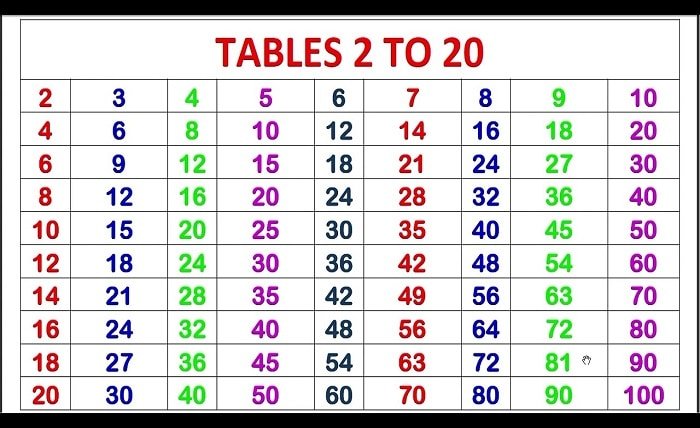Comprehensive Guide to Multiplication Tables 2 to 20

Multiplication Tables 2 to 20
Multiplication is one of the core concepts in mathematics, and mastering multiplication tables 2 to 20 is essential for building a strong foundation in arithmetic. Whether you’re a student, teacher, or anyone looking to enhance their math skills, knowing the multiplication tables can significantly simplify many math problems. In this blog post, we will guide you through the multiplication tables from 2 to 20, offering tips, tricks, and techniques to help you memorize and apply them efficiently.
Why Learning Multiplication Tables 2 to 20 is Important
Learning multiplication tables 2 to 20 is crucial for several reasons. First, these tables lay the groundwork for higher-level math concepts, such as algebra, geometry, and calculus. By memorizing the multiplication tables, you will be able to solve problems more quickly and with greater confidence. Furthermore, these tables come in handy in everyday situations, from calculating prices during shopping to measuring distances and cooking ingredients. The more familiar you become with tables 2 to 20, the easier it will be to handle complex math problems.
Multiplication Table 2 to 20: A Quick Overview
To give you a clearer picture, let’s first take a look at the multiplication tables 2 to 20. This overview will serve as a reference for students and professionals alike:
Table 2:
- 2 x 1 = 2
- 2 x 2 = 4
- 2 x 3 = 6
- 2 x 4 = 8
- 2 x 5 = 10
- 2 x 6 = 12
- 2 x 7 = 14
- 2 x 8 = 16
- 2 x 9 = 18
- 2 x 10 = 20
Table 3:
- 3 x 1 = 3
- 3 x 2 = 6
- 3 x 3 = 9
- 3 x 4 = 12
- 3 x 5 = 15
- 3 x 6 = 18
- 3 x 7 = 21
- 3 x 8 = 24
- 3 x 9 = 27
- 3 x 10 = 30
Table 4:
- 4 x 1 = 4
- 4 x 2 = 8
- 4 x 3 = 12
- 4 x 4 = 16
- 4 x 5 = 20
- 4 x 6 = 24
- 4 x 7 = 28
- 4 x 8 = 32
- 4 x 9 = 36
- 4 x 10 = 40
And similarly for tables 5 to 20.
This quick guide serves as a helpful reference point to start learning the tables in-depth.
Techniques for Memorizing Multiplication Tables 2 to 20
Memorizing multiplication tables 2 to 20 might seem daunting, but with the right techniques, anyone can do it efficiently. Here are some tips and strategies for memorization:
- Practice Repetition: Repetition is key when memorizing multiplication tables. Start with a few tables at a time and practice them daily. Repetition will help you retain the tables better.
- Chunking Method: Break down the multiplication tables into smaller sections. For example, focus on memorizing the multiples of 2, then move on to multiples of 3, and so on. This helps in reducing the overwhelming feeling.
- Use Rhymes or Songs: Many people find it helpful to use rhymes or songs when learning multiplication. There are plenty of educational songs available that make learning fun.
- Flashcards: Using flashcards is an excellent way to test your knowledge. Write the multiplication question on one side and the answer on the other. Testing yourself regularly will reinforce your memory.
- Visual Aids: Visual aids like multiplication charts or number grids can also help. These charts offer a clear layout of all multiplication tables from 1 to 12 (and beyond), making it easier to see patterns.
The Patterns Within Multiplication Tables 2 to 20
One of the most interesting aspects of multiplication tables 2 to 20 is the patterns that emerge as you progress. Recognizing these patterns can make learning multiplication more intuitive. Let’s take a look at a few examples:
- Multiples of 2: All numbers in the 2 times table are even. The sequence follows a consistent pattern: 2, 4, 6, 8, 10, and so on.
- Multiples of 5: In the 5 times table, every product ends in either a 0 or a 5. This makes it easier to predict the result of any multiplication involving 5.
- Multiples of 10: The 10 times table is simple because every product ends in a 0. This is often one of the first tables children learn, and the pattern makes it easy to remember.
Understanding these patterns across all multiplication tables from 2 to 20 can greatly simplify the process of learning and recalling results.
Applications of Multiplication Tables 2 to 20 in Real Life
Multiplication tables 2 to 20 are not only vital in math classes, but they also have practical applications in real life. Here are a few examples of how multiplication is used every day:
- Shopping and Budgeting: Whether you are calculating the total cost of items or working out discounts, multiplication tables come in handy when handling money and purchases.
- Cooking and Baking: When adjusting recipes to serve more or fewer people, knowing your multiplication tables can help you scale ingredients easily.
- Time Management: Multiplication tables are used in scheduling and planning, such as calculating the time it will take to complete multiple tasks or when planning events.
- Sports: In sports like basketball or football, coaches and players often use multiplication to calculate stats, scores, and averages.
- Construction and DIY: In building projects, multiplication is frequently used to determine area, volume, and material quantities.
Challenges in Learning Multiplication Tables 2 to 20
While learning the multiplication tables 2 to 20 can be fun and rewarding, it’s not without its challenges. Here are some common hurdles students face:
- Overwhelming Amount of Information: Memorizing all the tables can seem like a lot to take in at once. It’s important to tackle them one by one and give yourself time to absorb each table.
- Difficulty with Larger Numbers: As the numbers get larger, such as when working with tables 15 to 20, the multiplication results become more complex. It’s essential to practice these tables consistently to become comfortable with them.
- Lack of Confidence: Some students may feel discouraged if they struggle to memorize the tables. It’s crucial to remain patient and practice regularly.
- Inconsistent Practice: Regular and consistent practice is essential when learning multiplication tables. Missing practice sessions can result in a lack of retention.
Conclusion
In conclusion, learning multiplication tables 2 to 20 is a vital skill that lays the foundation for many other mathematical concepts. By using techniques like repetition, pattern recognition, and real-life applications, anyone can improve their multiplication skills. Consistent practice and patience are key to mastering these tables, and with time, you will find that multiplication becomes second nature. Whether for school, work, or daily activities, having a solid grasp of multiplication tables 2 to 20 is a valuable asset.
FAQs
1. How can I easily memorize multiplication tables 2 to 20?
Repetition, visual aids like charts, and the chunking method are effective strategies. Also, using flashcards or songs can make the process more fun.
2. Why are multiplication tables 2 to 20 important?
They are foundational for higher-level math and are used in everyday tasks like budgeting, cooking, and time management.
3. What’s the best way to practice multiplication tables?
Regular practice through quizzes, flashcards, and timed tests will help reinforce your knowledge. It’s also helpful to use multiplication apps or games.
4. Are there any shortcuts for learning multiplication tables 2 to 20?
Yes! Look for patterns in the tables, such as multiples of 5 always ending in 0 or 5. Learning these patterns makes it easier to memorize the tables.
5. How long does it take to memorize multiplication tables 2 to 20?
It varies from person to person. However, consistent practice over a few weeks can lead to mastery. Start by learning a few tables at a time and gradually move to more complex ones.





